The transformation of Mount Athos and its monastic character
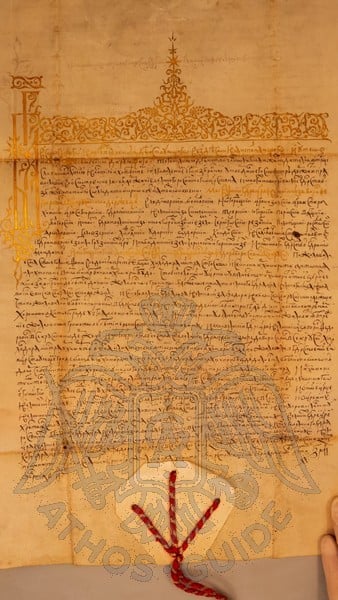
The Byzantine empire was particularly interested in the Athonite state. During the Ecumenical Council of 843, which was attended by representatives of Mount Athos, great conversations were devoted to the character of the peninsula and the way in which the monasteries should be organized. However, the first reference to the state of Mount Athos is found in a document that dates back to 883. Over the next 60 years, many similar texts were published, testifying the efforts and interest of the Byzantines in the creation of the monastic community of Athos.
The first document was an imperial decree (sigil) of Basil I. Its content proves that it was issued at the request of the athonite fathers, who were granted the permission to establish a special monastic regime. As stipulated, among other things:
1. It is forbidden by anyone, a general or a common citizen, to disturb the monks of Mount Athos.
2. It is forbidden to graze cattle on the territory of Mount Athos.
When the Emperor Leo VI ascended the throne, the representatives of the commune of Kolovos asked for the confirmation of the sigil issued by Basil I, modifying its contents so that the whole land of Athos was given to them. In this way they claimed the lands of the neighboring monasteries, which caused a great disagreement. Shortly afterwards the document was destroyed by royal order. However, its content came down to us through a decree of 893, in which extensive reference was made to the terms of the previous decree of 887.
The copy of Leo the Wise's second document was a confirmatory decree, which has been entirely preserved. It summarized the terms of the first document, which was annulled, and reaffirmed the first decree of Basil I. There they were appointed:
- The right of possession of the territories by the athonite monks and the prohibition of their disturbance.
- The right of possession of the territories by the local lay inhabitants and the prohibition of their disturbance.
- The restriction of the territorial expansion of the commune of Kolovos in the area of the fortress of Ierissos.
- The general use of all other areas.
The Emperor Romanus I confirmed the decree of Leo the Wise and abolished the taxation of the athonite community by any bishop or ruler. The same document was reissued in August 934.
In all the above cases, Athos was presented as a legal entity with self-government, with representatives in power and with its own property.
The borders of Mount Athos with the neighboring territories, i.e. with the small or large monasteries that did not belong to the Athonite state, as well as with the communities of Ierissos and the surrounding settlements, were known and protected by the inhabitants themselves. Thus, all the aforementioned documents imposed respect for the boundaries, without really defining them.
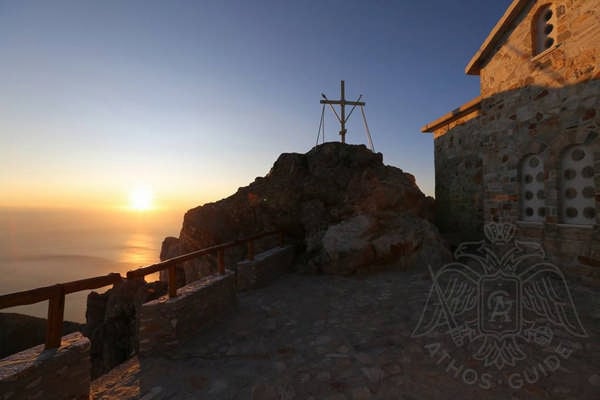 Between Athos and the fortress of Ierissos there were some areas abandoned for more than 30 years. These were transferred to the Byzantine state, divided into parcels of land and, on payment of rent, could be sown or used for grazing. They were claimed both by Athos and by the inhabitants of Ierissos, the commune of Kolovos and other monasteries. The boundaries of the lands, in relation to the fortress of Ierissos, had already been determined, while the boundaries of Mount Athos remained in dispute. Of course, the monks of the earlier times did not need and did not even have the ability to cultivate those intermediate lands.
Between Athos and the fortress of Ierissos there were some areas abandoned for more than 30 years. These were transferred to the Byzantine state, divided into parcels of land and, on payment of rent, could be sown or used for grazing. They were claimed both by Athos and by the inhabitants of Ierissos, the commune of Kolovos and other monasteries. The boundaries of the lands, in relation to the fortress of Ierissos, had already been determined, while the boundaries of Mount Athos remained in dispute. Of course, the monks of the earlier times did not need and did not even have the ability to cultivate those intermediate lands.
However, with the growth of monasticism, the need to expand the land arose. The situation was further complicated by the invasion and settlement of Bulgarian populations during the 10th century.
In 942, the ruler of Thessaloniki sold to the inhabitants of Ierissos one of the plots of land that was bordering Athos. The monks opposed, claiming that the lands granted belonged to Mount Athos. The disagreement was due to a misinterpretation of the phrase "territory of Ierissos" in a relevant document of 893. According to the monks, this definition included the area of the fortress. Consequently, the suburbs of Ierissos were considered to be the territory of Mount Athos. On the contrary, the inhabitants of Ierissos insisted that the term referred to a specific economic and administrative unit and that the borders of Athos were much further south, below the isthmus. The official decision issued was in favor of the inhabitants of Ierissos. The Emperor Romanos Lekapenos ordered the governor of Thessaloniki to control the whole issue and mark the boundaries of the disputed lands. The Metropolitan Gregory of Thessaloniki had also participated in the judicial process over the determination of the boundaries. The two sides, the athonite monks and the inhabitants of Ierissos, signed an agreement on the 15th of March 942. Among other things, there was appointed the on-site supervision of the execution of this decree.
The document was signed by five representatives of Ierissos, three abbots of the surrounding monasteries and four athonite fathers. The borders were formed on the ground with stones and trees planted especially for this purpose. A decree was also issued but later got lost. However, its content is known to us through a report that was sent to the emperor in order to inform him of the completion of the procedure.
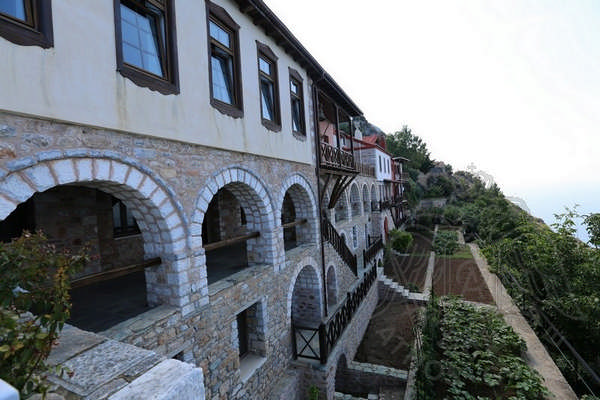 According to this report, the boundaries of the monastic state passed through the area of Zygos. However, the land was considered 'scarce and useless'. Instead, the locals were given by royal decree a plot of land of 2,000 modi from the commune of Kolovos. The ownership of Athos was also recognised in the lands southern of the locals’ villages. Additionally, people were allowed to graze their cattle in nearby areas. The border could be crossed only in case of a threat to national security and only after a permission was granted by the athonite monks.
According to this report, the boundaries of the monastic state passed through the area of Zygos. However, the land was considered 'scarce and useless'. Instead, the locals were given by royal decree a plot of land of 2,000 modi from the commune of Kolovos. The ownership of Athos was also recognised in the lands southern of the locals’ villages. Additionally, people were allowed to graze their cattle in nearby areas. The border could be crossed only in case of a threat to national security and only after a permission was granted by the athonite monks.
In 943, the borders were redrawn, since the previous agreement was questioned. The General Katakalos, accompanied by the Metropolitan Gregory of Thessaloniki and the judicial representative, visited the region of Ierissos in order to mark the new borders. However, these coincided with the borders that his predecessor had already defined and which were explicitly mentioned in the previous document. The boundary started from the isthmus, opposite the old palace of Ammouliani, and went up towards the fields of Saint Christina, where there was a stone enclosure. They continued along the canal, climbing the hill and reaching the old aqueduct. The ancient stone structure of the Kolovos commune was now within the boundaries of Mount Athos. Finally, a copy of the official document was handed over to the relevant parties.
The deep channel opposite the old palace of Ammouliani was a landmark and helped to delimit the territories. Since for the following centuries no attempt was made to revise the territories of Mount Athos, the boundaries established by General Katakalos are still valid to this day. The athonites managed through all the above to expand the territories of the monastic community, to include the land from the area of Zygos to Proaulaka and from Proaulaka to Ierissos.
The monasteries that were built there came under the administration of Mount Athos. Thus, the map of the Athonite state was finally formed.
Prosperity and growth of monasticism
The 10th century was a period of prosperity for the monastic life of Mount Athos. It was the time of transformation, the rise and prosperity of the political and spiritual powers of the Byzantine Empire.
During the Macedonian dynasty, progress in all individual areas of political and social life enhanced progress within Athos as well. Prosperity facilitated the further development of the Athonite monasteries. The deliverance from the raids of Arab pirates, after the liberation of Crete and the control of the Mediterranean by Nikiforos Fokas, contributed decisively to the well-being of the monastic communities. As for the Bulgarian invasion, it did not affect Mount Athos at all.
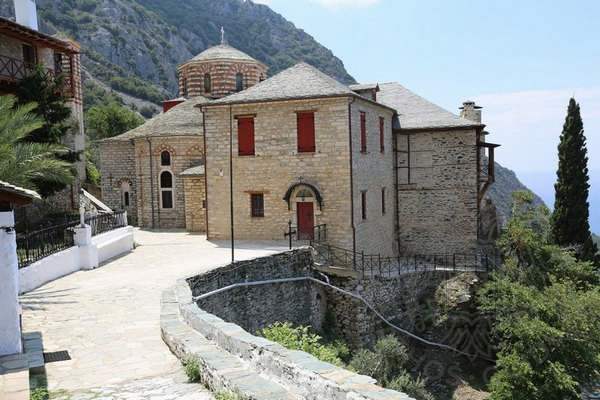 Despite his interest in the monastic communities, Nikiforos Fokas issued a decree forbidding the transfer of land to the monasteries of Mount Athos, as this had proved unprofitable for the Byzantine state. The decree of Basil II, which annulled this decision, facilitated the further development and strengthening of the institution of monasticism. Until then there had only been huts and cells, some of which developed into small monasteries. However, they still lacked the right of ownership, as the entire territory belonged to the Holy Monastery of Great Lavra.
Despite his interest in the monastic communities, Nikiforos Fokas issued a decree forbidding the transfer of land to the monasteries of Mount Athos, as this had proved unprofitable for the Byzantine state. The decree of Basil II, which annulled this decision, facilitated the further development and strengthening of the institution of monasticism. Until then there had only been huts and cells, some of which developed into small monasteries. However, they still lacked the right of ownership, as the entire territory belonged to the Holy Monastery of Great Lavra.
From the middle of the 10th century, larger monasteries began to raise, given their own land by the Monastery of Great Lavra or by the emperor. Thus, both the older and small monasteries as well as the newer larger ones, following the example of Great Lavra, began to build stone structures, gates and watchtowers to defend themselves from invasions.
By the mid-16th century, the process of founding a new monastery appeared to be quite simple. Over the centuries and through the long history of Mount Athos, there have been hundreds of monasteries, some of which remain active until today, while others have been abandoned.
Население Святой Горы
Studying the history of Mount Athos, we come across a number of monasteries that were founded, went through periods of prosperity and decline, were deserted or remained alive until today. The growth of new monasteries coincides with the period of spiritual, economic and cultural prosperity of the athonite peninsula and the Byzantine Empire. The two most important periods, during which there was an intense growth, were the period from 980 to 1060 and from 1290 to 1370. During these years hundreds of monasteries were founded and actively involved in the organization of the Athonite state. Thus began the process of unification and absorption of the smaller monastic communities by the larger ones.
The number of monasteries decreased due to the mergers of the monastic communities, but still remained high. The same processes continued until the 16th century, when there were 20 monasteries all throughout the athonite territory.
 The changes in the population of Mount Athos coincide with changes in the monastic institutions, the history of whom cannot easily be distinguished. In 972 the Monastery of Great Lavra seems to have consisted of the abbot, two monks and 120 subordinates. It is estimated that 40 subordinates lived in the Holy Monastery of Xeropotamou, while the other monasteries had 15 people each. The total number of athonite citizens is estimated at 1,000. Around 1020, when the story of the life of Saint Athanasios the Athonite was written, there was made the first reference to the population of Mount Athos. It is mentioned that there were three thousand monks. Then, in 1045, the Monastery of Great Lavra was estimated to consist of 700 athonites, the Holy Monastery of Vatopaidi and the Holy Monastery of Iviron of 450, while in the other 180 monasteries there were on average 20 subordinates. The population of Athos in the middle of the 11th century was 6,000 inhabitants.
The changes in the population of Mount Athos coincide with changes in the monastic institutions, the history of whom cannot easily be distinguished. In 972 the Monastery of Great Lavra seems to have consisted of the abbot, two monks and 120 subordinates. It is estimated that 40 subordinates lived in the Holy Monastery of Xeropotamou, while the other monasteries had 15 people each. The total number of athonite citizens is estimated at 1,000. Around 1020, when the story of the life of Saint Athanasios the Athonite was written, there was made the first reference to the population of Mount Athos. It is mentioned that there were three thousand monks. Then, in 1045, the Monastery of Great Lavra was estimated to consist of 700 athonites, the Holy Monastery of Vatopaidi and the Holy Monastery of Iviron of 450, while in the other 180 monasteries there were on average 20 subordinates. The population of Athos in the middle of the 11th century was 6,000 inhabitants.
In the following centuries, and especially during the Turkish occupation, the population gradually decreased. From the 15th century onwards, the number of athonites was estimated at 1,500.
List of the Athonite monasteries
During the 13th century, the Byzantine Empire experienced the most critical period of its history. This living organism, which had developed a great civilization with faith and love for the orthodoxy, was resisting threats with vigor. Fierce attacks from other tribes were unable to break the empire, which continued to be a stronghold of the spiritual wealth that had been produced over the centuries.
Its power weakened when the Western Europe joined the tribes that threatened Byzantium from the east. Constantinople, which for nine hundred years had been the capital of the empire (first of the Roman pagan state and then of the Byzantine Christian world) was conquered in 1204.
The devastation caused to the Byzantine Empire by the Fourth Crusade had also affected Mount Athos. Fierce raids by pirates and other conquerors began, causing irreparable damage to the athonite monasteries. It was only in the 14th century that Mount Athos managed to regain its glory, under the protection of the imperial family of the Palaeologans, as well as the Patriarchate.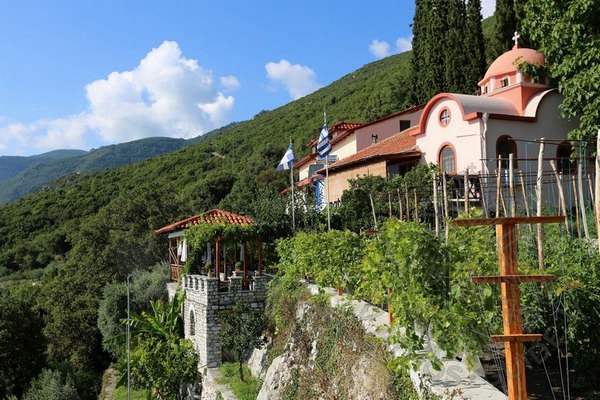
Among other things, the result of the Fourth Crusade was the incorporation of Athos into the Frankish kingdom of Thessaloniki, as the Greek people of Macedonia and Thrace had already been subjugated to the West.
From the period of Frankish rule (1204-1221), we have no references to the Protos of Mount Athos. It can thus be concluded that this position was abolished, since the Protos was a person closely connected with the Byzantine emperor, who had been deposed at that time. According to historical sources, the administration passed to the Bishop Sevastatos, with the blessing of Pope Innocent III.
The bishop was the guardian of Athos. However, the monks did not welcome the changes in their civil organization. The bishop's residence was located outside the monastic state, in the place that is still called today Fragokastello. Using his position, he ensured, in exchange of a fee, unhindered access to the Franks, who plundered the monasteries and exploited the local population.
When the monks decided to turn to the Latin emperor Henry I (1206-1216), asking him for help, he hesitated to take part in the athonite disputes. According to the Western European hierarchy, Mount Athos belonged to the sphere of influence of the Pope of Rome and, therefore, the emperor could not intervene in the affairs of the Athonite state. However, in 1214, the Pope sent a letter to the representatives of Mount Athos explaining that he was aware of the problem. In this letter, it was reported that a trusted person informed him of an enemy of the church, who, like a pirate, had built a fortress and threatened the monks. The bishop was expelled by a decree of Henry I. The athonites remained forever grateful to the Latin emperor. The Pope himself referred to Mount Athos with the following descriptions:
"Your mount, adorned with three hundred monasteries and a great number of men of great spiritual blessing, is truly a holy place, the house of the Lord and the gate to heaven. That is why all people love it so much. That is why it is under the protection of the bishops and rulers of all ages."
The next pope, Honorius III, had a very different attitude towards the Athonite state. In 1223 he decided to deprive Mount Athos of the lands within its borders.

However, as early as 1221 the monasteries were under the protection of the future ruler of the region, Theodore Komnenos Doukas, so the protection of the pope was no longer necessary.
The latter, as a ruler of the Despotate of Epirus, proclaimed himself emperor and put an end to the Latin domination of the Greek territory. He appointed Greek bishops everywhere and reorganized the state. It was during this period that we notice the reappearance of the position of Protos in Mount Athos.
Theodore's reign did not last long, as in 1230 he was captured as a prisoner by the Bulgarian King Ivan Asen and the throne passed to his brother Manuel Angelos. The Bulgarian king visited Mount Athos immediately after his victory. Filled with pride, he generously gave gifts to the monasteries and especially to the Holy Monastery of Great Lavra. His aim was to place capable people in key positions in the Greek Orthodox Church.
Saint Sava, the Athonite and archbishop of Serbia, strongly resisted the growing Bulgarian presence. The monks themselves opposed to the gradual influence and domination of Bulgarian culture. Over 3,000 athonites gathered in Karyes and protested against the imposition of foreign rules. The problem was resolved after the Greek emperor met the Bulgarian king at the wedding of their children. There it was decided that they would both stop getting involved into the affairs of Mount Athos. The Patriarchate of Bulgaria, the Bishop of Ierissos and the Metropolitan of Thessaloniki had to stop interfering and influencing the life of the athonite fathers.
In 1246 Mount Athos was returned to the administration of the Byzantine emperor, John Vatatzis. From that moment and until the mid-14th century, the region experienced a period of spiritual flourishing, despite piracy, individual wars and the tragic events that the Byzantine Empire was experiencing.

